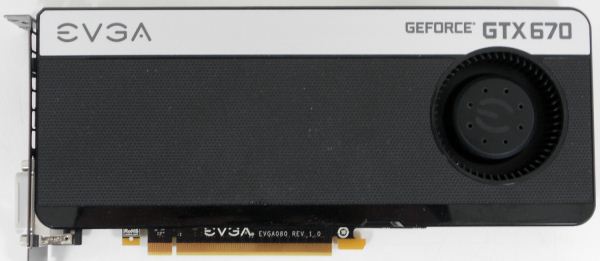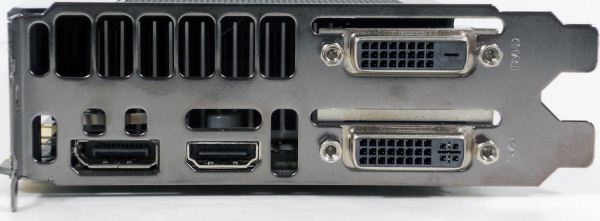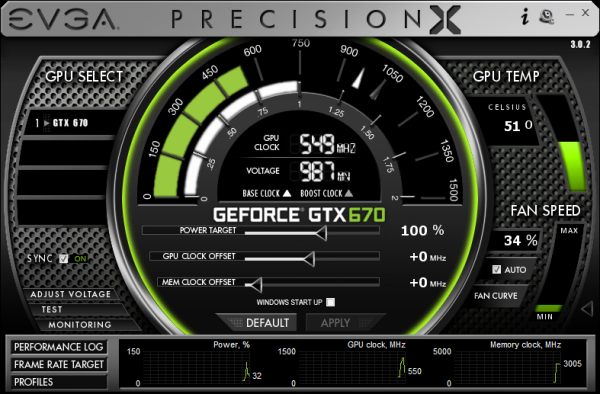NVIDIA GeForce GTX 670 Review Feat. EVGA: Bringing GK104 Down To $400
by Ryan Smith on May 10, 2012 9:00 AM ESTMeet The EVGA GeForce GTX 670 Superclocked
Our second card of the day is EVGA’s GeForce GTX 670 Superclocked, which in EVGA’s hierarchy is their first tier of factory overclocked cards. EVGA is binning GTX 670s and in turn promoting some of them to this tier, which means the GTX 670 Superclocked are equipped with generally better performing chips than the average reference card.
| GeForce GTX 670 Partner Card Specification Comparison | ||||
| EVGA GeForce GTX 670 Superclocked | GeForce GTX 670 (Ref) | |||
| CUDA Cores | 1344 | 1344 | ||
| Texture Units | 112 | 112 | ||
| ROPs | 32 | 32 | ||
| Base Clock | 967MHz | 915MHz | ||
| Boost Clock | 1046MHz | 980MHz | ||
| Memory Clock | 6210MHz | 6008MHz | ||
| Memory Bus Width | 256-bit | 256-bit | ||
| Frame Buffer | 2GB | 2GB | ||
| TDP | 170W | 170W | ||
| Manufacturing Process | TSMC 28nm | TSMC 28nm | ||
| Width | Double Slot | Double Slot | ||
| Length | 9.5" | 9.5" | ||
| Warranty | 3 Years | N/A | ||
| Price Point | $419 | $399 | ||
For the GTX 670 SC, EVGA has given both the core clock and memory clock a moderate boost. The core clock has been increased by 52MHz (6%) to 967MHz base and 66MHz (7%) boost to 1046MHz. Meanwhile the memory clock has been increased by 202MHz (3%) to 6210MHz.
Other than the clockspeed changes, the GTX 670 SC is an almost-reference card utilizing a reference PCB with a slightly modified cooler. EVGA is fabricating their own shroud, but they’ve copied NVIDIA’s reference shroud down to almost the last detail. The only functional difference is that the diameter of the fan intake is about 5mm less, otherwise the only difference is that EVGA has detailed it differently than NVIDIA and used some rounded corners in place of square corners.
The only other change you’ll notice is that EVGA is using their own high flow bracket in place of NVIDIA’s bracket. The high flow bracket cuts away as much metal as possible, maximizing the area of the vents. Though based on our power and temperature readings, this doesn’t seem to have notably impacted the GTX 670 SC.
While we’re on the matter of customized cards and factory overclocks, it’s worth reiterating NVIDIA’s position on factory overclocked cards. Reference and semi-custom cards (that is, cards using the reference PCB) must adhere to NVIDIA’s power target limits. For GTX 670 this is a 141W power target, with a maximum power target of 122% (170W). Fully custom cards with better power delivery circuitry can go higher, but not semi-custom cards. As a result the flexibility in building semi-custom cards comes down to binning. EVGA can bin better chips and use them in cards such as the Superclocked – such as our sample which can go 17 boost bins over the base clock versus 13 bins for our reference GTX 670 – but at the end of the day for stock performance they’re at the mercy of what can be accomplished within 141W/170W.
In any case, as the card is otherwise a reference GTX 670 EVGA is relying on the combination of their factory overclock, their toolset, and their strong reputation for support to carry the card. EVGA has priced the card at $419, $20 over the GTX 670 MSRP, in-line with other factory overclocked cards.
On the subject of pricing and warranties, since this is the first EVGA card we’ve reviewed since April 1st, this is a good time to go over the recent warranty changes EVGA has made.
Starting April 1st, EVGA has implemented what they’re calling their new Global Warranty Policy. Starting July 1st, 2011 (the policy is being backdated), all new EVGA cards ship with at least a 3 year warranty. And for the GTX 600 series specifically, so far EVGA has only offered models with a 3 year warranty in North America, which simplifies their product lineup.
To complement the 3 year warranty and replace the lack of longer term warranties, EVGA is now directly selling 2 and 7 year warranty extensions, for a total of 5 and 10 years respectively. So instead of buying a card with a 3 year warranty or a longer warranty, you’ll simply buy the 3 year card and then buy a warranty extension to go with it. However the extended warranty requires that the card be registered and the warranty purchased within 30 days.
The second change is that the base 3 year warranty no longer requires product registration. EVGA has other ways to entice buyers into registering, but they’ll now honor all applicable cards for 3 years regardless of the registration status. At the same time the base 3 year warranty is now a per-product warranty (e.g. a transferable warranty) rather than per-user warranty, so the base warranty will transfer to 2nd hand buyers. The extended warranties however will not.
The third change is how EVGA is actually going to handle the warranty process. First and foremost, EVGA is now allowing cards to be sent to the nearest EVGA RMA office rather than the office for the region the card was purchased from. For example a buyer moving from Europe to North America can send the card to EVGA’s North American offices rather than sending it overseas.
Finally, EVGA is now doing free cross shipping, alongside their existing Advanced RMA program. EVGA will now cross-ship replacement cards for free to buyers. The buyer meanwhile is responsible for paying to ship the faulty card back and putting up collateral on the new card until EVGA receives the old card.
There’s also one quick change to the step-up program that will impact some customers. With the move to purchasing extended warranties, the step-up program is only available to customers who either purchase an extended warranty or purchase an older generation card that comes with a lifetime warranty. Step-up is not available to cards with only the base 3 year warranty.
Moving on, along with EVGA’s new warranty EVGA is bundling the latest version of their GPU utilities, Precision X and OC Scanner X.
Precision X, as we touched upon quickly in our GTX 680 review, is the latest iteration of EVGA’s Precision overclocking & monitoring utility. It’s still based on RivaTuner and along with adding support for the GTX 600 series features (power targets, framerate caps, etc), it also introduces a new UI. Functionality wise it’s still at the top of the pack along with the similarly RivaTuner powered MSI Afterburner. Personally I’m not a fan of the new UI – circular UIs and sliders aren’t particularly easy to read – but it gets the job done.
OC Scanner X has also received a facelift and functionality upgrade of its own. Along with its basic FurMark-ish stress testing and error checking, it now also offers a basic CPU stress test and GPU benchmark.



















414 Comments
View All Comments
Spunjji - Friday, May 11, 2012 - link
Thank you for being a voice of sanity in an otherwise brutally argumentative and deeply sad comments section. +1 to you.CeriseCogburn - Friday, May 11, 2012 - link
"Voice of sanity" your amd fanboy friend, got the 43% larger amd wafer die size "cost drop not a problem" a bit overlooked, not to mention the 3 added free games additional cost.Is it a voice of reason to claim the largest base cost of the card at 43% greater is no problem since the "dies" are "about the same size" ?
ROFL... tsk tsk.
SlyNine - Saturday, May 12, 2012 - link
Its 43% greater now.Also you seem to forget the 7970 wins in 5 out of 10 of Anandtechs benchmarks.
Since you're going to argue this with me I'll put it out right now.
Crysis AMD
Metro AMD
Dirt 3 ( on the MOST Intensive test 5760x1200 min frames) Tied, but to me min frames is more important so I'd rather have AMD in that situation.
Now you can argue , But NVidia wins on the other res's But since this is the ONLY time it even gets below 60 this is the ONLY test that it really makes a difference.
ShoGun, AMD, big time, ya nvidia wins when FPS is over 100, but AMD wins by a lot when FPS is at a premium. With a driver fix I'm sure it will be a lot closer.
Batman, Basically a tie, yea Nvidia takes it but C'mon, 1 fps when it matters most. My guess is if they added 4x aa to the 3 screen mode AMD would take it.
Portal 2 Nvidia kills AMD, esp. in the high res, because that's where fps are low enough that the diff matters.
Battlefield 3 Nvidia kills amd again. and again when FPS matters.
SC2, Nvidia is faster. FPS is so high it doesn't matter But AMD is catching up fast and with the 5760res I wonder if AMD wouldn't' win. and by then FPS might actually matter.
Skyrim, same as SC2, AMD is catching up fast at the higher resolution, if it keeps going AMD might come out ahead where FPS is low enough that the difference matters.
Civ 5, tie. With the trend the Nvidia might be better at higher res here.
Portal 2 and BF3 are the to situation in Anands testing suit where Nvidia is MUCH better.
But other than that FPS either doesn't matter or AMD is winning when FPS is low enough that the difference matters.
As far as future games, we have NO idea what card might be better, but AMD does seem to have more raw power, and has more ram.
In compute AMD won 2 , loses one by like 7% and then actually loses one by a lot. Of course it doesn't have a cuda score so how to you count that as a loss, that's stupid.
CeriseCogburn - Sunday, May 13, 2012 - link
You make excuses across the board for the amd card, and nVidia's card is a smoother experience anyway if you want to glom onto min frames - and we haven't even used things like adaptive v-sync (better min frame rates for nVidia), nor did you figure in the enormous drivers difference.It's just such a huge gap when everything is considered it's beyond ridiculous to go for the amd card, as this amd favoring reviewer even admits.
Have your favorite brand, but you've got stretch and spin to justify it.
Galidou - Sunday, May 13, 2012 - link
I could just really stop answering you if that wasn't for the fact you're being so much disrespectful. I have a little problem with people lacking of respect, I have to let them know they are, even more when they do not think they are lacking respect...CeriseCogburn - Sunday, May 13, 2012 - link
You have never answered anything late comer troll Galidou, you're a pure 100% trolling personal attacker right now fella in all your posts so far. You have said absolutely nothing, so it is clear you should have never posted.Galidou - Monday, May 14, 2012 - link
I'm not attacking your person, just the way you throw your arguments at people calling them names like they are pure ignorant worthless living zombies... it just feels that way...Gastec - Tuesday, November 13, 2012 - link
"You make excuses across the board for the amd card, and nVidia's card is a smoother experience[..] - and we haven't even used things like..."We? WE?? YOU are from NVIDIA???? And you post here and admit it? I think you can get fired for doing this.
Or maybe you are not from nVidia but because you use a nVidia card you, for some very disturbing reason, feel like you are part of the company?
CeriseCogburn - Friday, May 11, 2012 - link
Okay, first of all substantial competition is the GTX590 and the 6990, that both still beat the overpriced amd lost 3 and only won 2 compute benchmarks in that 2.5+ month evil amd price scalping period before the massive smack down the nVidia 680 delivered.Now nVidia made a third move, the 670, not the initial move as you spoke about it, and this third move is another massive smackdown on the already smacked down by the 680 failing and utterly depleted value 7970 has to endure.
Nice try pretending the 1st smack down just occurred, but once again, what else to expect from an amd fanboy, and also clearly why another amd fanboy immediately thanked you a perfectly leveled headed post. LOL
Now onto your other ridiculous spew, based on facts not twisted perceptions.
You note the die sizes of the competing products, and conclude by stupid first look there is no reason amd cannot drop it's price (again) - you avoid the again, twice - (once for $$$(yes 3 figures), twice for 3 games added, now a 3rd time coming ) - but whatever, let's take your die size non chalant info and do our little math amd fanboys now desperately want to avoid.
300mm sq. nVidia vs 365mm sq Amd - doesn't look so bad does it ?
Unfortunately, the Amd die is well over 40% LARGER :)
Sorry about that amd fanboy brainfart .... you forgot to multiply for AREA, hence size/cost of the wafer....
300x300 vs 365x365
90,000 nVidia wafer area vs 133,225 huge 43% + more amd wafer cost.
So let's get this straight - do you still not really see a problem ?
yankeeDDL > " AMD will need to drop the prices and I see really no reason why they couldn't, as they have just a marginally larger die size (300mm2 vs 365mm2) on the same fab/technology. "
So 43% plus more base cost, no problem going a hundred bucks + games costs less... ?
R O F L
Thank you, as the amd fanboy said, for being such a clear thinking person with a calm and fair mind... (rolls eyes)
SlyNine - Saturday, May 12, 2012 - link
Its hard to say the 680 was a smack down when most people couldn't even get the card..You seem to be angered by the 7970. I agree that it was not a good deal. But its not a bad card either.